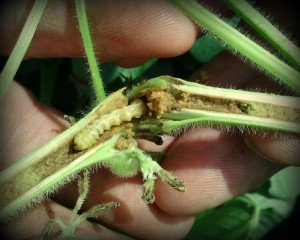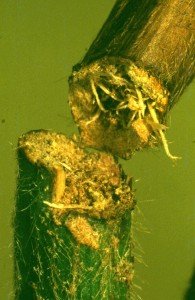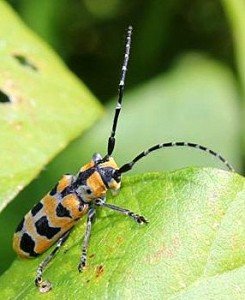Lucerne crown borer (Zygrita diva) (LCB) is causing severe damage in a number of soybean crops in the Bundaberg region of SE Qld, and on the North Coast region of NSW. In some cases up to 75% of plants are infested and early plant death is evident.
Damage seems to be worse in the early (November-planted) crops which were sown in or adjacent to paddocks planted to soybeans last year.
In some early crops, larvae are already pupating, with stem girdling and plant death occurring in crops that are only at the pod set stage. In these crops, it is likely that, after pupation, emerging beetles will re-infest the crop. The second round of pupation will most likely not occur until pods are fully filled, but this could be earlier if heat wave conditions return.
Once only a sporadic pest in some seasons, LCB numbers seem to be increasing in coastal soybean growing regions. However, because of its biology and feeding behaviour, control is difficult.
Biology and Damage
LCB overwinter as pupae in soybean stem stubble. Beetles emerge in the spring/early summer. They are not strong fliers, and hence soybean planted in paddocks that had soybean the previous season (or adjacent to such paddocks) are at greater risk.
The proximity to other LCB hosts such as lucerne and phasey bean is also a risk factor.
Adult crown borers lay eggs in a slit in the stems of young plants. The hatching larvae then tunnel immediately into the stems where they feed on the stem pith, i.e. not the vascular tissue. Larval feeding in the pith does not affect yield, but the damage is caused when larvae commence pupation. Larvae girdle (internally ringbark) the lower stem to plug the pith tunnel and pupate in the tap root.
LCB damaged pith turns a red brown to orange colour, but be aware that tunnelling by other pests can cause a similar discolouration.
Pupation can be triggered as crops dry down or through heat stress, especially in early planted crops. In crops where pupation occurs when pods are not yet set or filled, yield losses can be severe. Yield losses are far lower if pupation occurs when pods are nearly or fully filled, provided that the damaged plants do not lodge before harvest.
Chemical control
Crown borer larvae cannot be controlled with insecticides. Because they feed on the pith inside stems, they cannot be reached even by systemic insecticides or those with ‘upward xylem mobility’ such as Altacor.
Although the adult crown borer may be susceptible to a number of insecticides, they invade crops over an extended period of time which would require multiple sprays to give satisfactory protection. Please note that NO insecticides are registered against LCB larvae or adults.
Cultural control
On a long-term area-wide basis, cultural control offers the best means of managing this pest effectively and sustainably, without creating other pest problems. Specific strategies include:
• Crop rotation: Do not plant soybeans in the same ground as last year. Where possible, plant crops as far as possible from last year’s plantings. Avoid plantings into or close to lucerne. Crop rotation is also a key strategy to reduce the build-up of inoculum of soil borne diseases such as charcoal rot and phomopsis.
• Weed control: Eliminate weed hosts such as phasey bean, sesbania and budda pea.
• Time of planting: Avoid early planting as these crops have a greater risk of early damage.
• Post-harvest cultivation: Aim to split stems and roots and bury stubble to a depth of at least 10 cm. Splitting the tap roots destroys LCB’s overwintering refuge, and burying stubble reduces the emergence of beetles in the following spring. This is a key strategy to attack the pest at its most vulnerable stage. Although cultivation opposes the zero till philosophy, strategic cultivations may be needed to not only manage this pest but also reduce the inoculum build-up of soil borne diseases such as charcoal rot and phomopsis.
• Minimize lodging: Higher sowing rates will lead to denser plant stands that can support girdled plants and reduce lodging.
• Minimise water stress: In irrigated crops, do not allow crops to become stressed. Stress can trigger early plant girdling. In dry-land crops, potential crop stress is a major reason to avoid those early plantings in which plants grow much larger, and hence need more water.
• Harvester set up: Ensure harvester set-up allows for picking up any side branches that have drooped or plants that have lodged due to LCB damage.
Other stem tunnelling pests
Other pests can also be found tunnelling in soybean stems. In recent summers, significant etiella outbreaks were reported in vegetative soybeans in the Burnett and Darling Downs in Qld, and in NW NSW. Major soybean stem fly outbreaks were reported the Northern Rivers of NSW in 2013 and lesser numbers in 2014. Stem fly were detected in relatively low numbers in the South Burnett in 2014, and have recently been reported in the Burdekin. A significant stem fly outbreak was reported near Mackay in 2009. Both etiella and stem fly cause similar discolouration of the pith, but their larvae are very different. Etiella larvae are pale green/cream with pink stripes, while soybean stem fly larvae are small maggots without a distinct head capsule.
Use the search function on the Beatsheet to find more information about Etiella and Soybean stem fly.
Article by Hugh Brier and Kate Charleston



